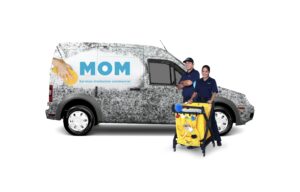Attracting more franchise customers is one way to generate more sales and drive growth, but so is making sure that those customers keep coming back for more. Indeed, according to a Harvard Business School study, improving customer retention by even 5% can increase profitability by anywhere from 25% to 95%.
The potential for customer retention to drive franchise growth, though, isn’t all that surprising when you think about it because customer retention is something that’s at the heart of every business. After all, you’re not going to be in business very long if your customers never come back.
This is why at MOM, we put so much into our customer care program. We know that for our franchisees to succeed, they have to grow, and one the best ways to help them do that is by helping them foster customer loyalty. There are a lot of ways we do that, but here 10 of the strategies that any business can use to improve its customer retention.
1. Set customer expectations
The old adage in regards to customer expectations is to set the bar at a reasonable height and then smash expectations. And it’s true: it serves no purpose to excite your customers with grandiose promises and then risk not delivering. Even if you do deliver, the best you’ll be able to do is just meet expectations. By establishing more modest expectations, however, your customer knows exactly what they’re in for, and you know precisely how far you have to go to really blow them away.
2. Go above and beyond
Often overlooked, going above and beyond your expectations is one of the best ways to retain customers. Once you set your expectations, surpass them and really woo your customers. When your customers think of how you went that extra mile for them, they’re going to be more likely to stick by your side when your competitors come knocking on their door.
3. Stand for something
We all like to think that we stand for something. Well, your products or service should be no different. After all, the value of a product or a service is much more than the sum of its parts. The real value of any product or service is in what it represents — whether that be an ideal such as efficiency or excellence, or a lifestyle. Customers tend to identify with brands and companies that share their values, and a great way to show them that you have shared values is to show them that you understand why they use products/services like yours.
4. Utilize positive social proof
Similar to a customer’s desire to stand for something, they also want to be part of a group or community that represents their interests and beliefs, and this is something you can do in all your communications — from your advertising to your face-to-face interactions. Instead of using negative terms and dissuasion tactics to veer customers away from competing brands by focusing on what other companies don’t have, explain the benefits of joining your company’s community of customers. Given customers the opportunity to feel like they belong to a community is far more enticing than telling them why your competitors aren’t as good as you.
5. Build trust through relationships
From certifications to free consolations, there are many ways you can establish your credibility, but you can also be proactive in sharing your insight and expertise. A company blog, newsletter, or YouTube channel are all effective ways of keeping your customers engaged and demonstrating your expertise at the same time.People do business with those they trust. More importantly, the more your clients trust you, the more business they’ll do with you. But trust goes beyond honesty. Customers also want to do business with someone they trust to be an expert.
6. Reduce pain points and friction
Nearly a quarter of your customers are what would typically be described as “conservative” spenders– or tightwads. These customers hold on to their cash more carefully, and it’s trickier to convince them of the tangible benefits of spending their money (with you).
A good way to reduce this friction is to break down the value of your product. For example, asking for a $1200 value over a year is a seemingly large investment, regardless of your offering. Breaking it down to $100 a month is perceived as a far more manageable price, and $23 a week, or even “only a few dollars a day” not only breaks down a precise price, but it also shows customers an exact daily value of your product.
Another good solution to overcoming pain points is to offer bundling. An expensive set of goods become more manageable when they’re sold together because it reduces the friction of multiple transactions.
For example, at MOM, we can bundle our janitorial services with a carpet cleaning program to offer our clients a better value. Basically, if your good is upgradeable (such as a car with optional sound system, seats, etc.), bundling makes your product more valuable, and reduces the stress that comes with buying a series of upgrades.
7. Speed is secondary to quality
At the end of the day, your client won’t remember how long they had to wait for your product or service if what you gave them totally knocks it out of the park. Conversely, your speedy service means nothing if what you’re offering is mediocre — or worse.
While speed and quality are a great combination when it comes to delivering great service, they aren’t equal in the eyes of your customer. Indeed, a Gallup poll found that “courteous, willing, and helpful” service makes customers nine times more likely to engage with you, whereas speed only makes customers six times more likely to engage.
8. Utilize surprise reciprocity
It’s said that the best good deeds come as a surprise, and without expectation of anything in return. Your customers know this, and the best way to show them that you genuinely care and have their best interests in mind is to send some unexpected goodwill their way.
This doesn’t have to be anything particularly large — after all, it’s the thought that counts. Send your clients some promotions when they least expect it, or maybe a season’s greeting message during the holidays. You’ll be surprised at the power of small but thoughtful, unexpected acts of kindness.
9. Make it personal
On the subject of unexpected good deeds, studies show that waiters are 23% more likely to receive a tip when they brought a second plate of mints to their customer’s table. It’s the idea of going that extra mile and giving your customer that personalized service. It reminds them that they’re not just another customer, and when you show them your appreciation, they’re much more likely to keep doing business with you.
10. Get ideal customers to be VIPs
People want to feel valued and important, and showing your customers that you’re important to them will make them more loyal to you. That being said, VIP programs mean little if there’s no real advantages to their status, so if you’re offering one, make sure that there’s some added value to being a member.
The Bottom Line
What it comes down to, is the cold, hard fact that customer retention is the cheapest, and strongest way to increase the profitability of your franchise business. By setting clear expectations, surpassing them, and showing your customers that you understand them on a variety of levels, you’ll be building a loyal customer base. And the wondrous thing about happy, loyal customers is that they not only drive growth and help secure your franchise business’s future, they’re around to share that success with you.



